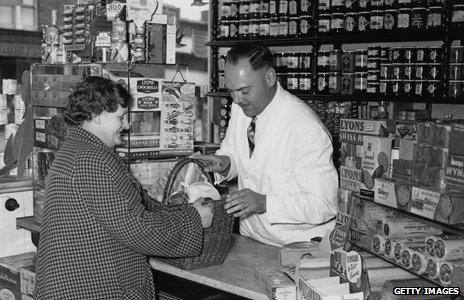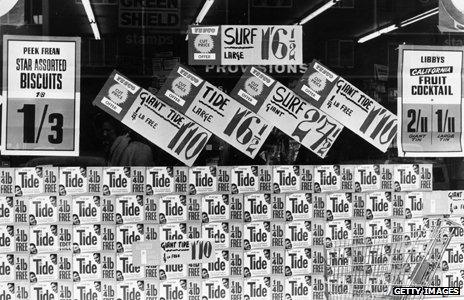How first out-of-town superstore changed the UK
- Published
Robert Peston visits Nottingham, where Asda introduced the first modern hypermarket
Nearly five decades have passed since the UK's first out-of-town superstore opened its doors. It differed starkly from the outlets used by millions today, but it helped change British shopping forever.
They circle the nation's suburbs, giant caverns of consumerism piled high with bulk-bought perishables.
Plenty of people loathe them, but millions rely on them. Out-of-town superstores - bigger, uglier brothers of standard-sized supermarkets - are an inescapable part of the modern British landscape.
Ubiquitous as they may be today, however, it's less than half-a-century since the first such outlet in the UK was launched.
When the country's first large-scale edge-of-city superstore was launched in West Bridgford, Nottinghamshire, the British public had never seen anything like it.
This vast new building boasted 110,000 sq ft (10,200 sq m) of floor space. It sold a spectacular array of groceries, hardware, furniture and clothes all under one roof, and there were parking spaces for 1,000 cars.
It boasted some 50 departments, including a pharmacy, sports goods, records, a restaurant, toys, a hairdresser, shoe repairs and carpets. Its stock and shop fittings were reportedly worth £700,000 - a huge figure at the time.
Developments like this would later be blamed for crushing independent traders, emptying out High Streets and imposing a stultifying homogeneity on the nation's retail habits.
But at a time when most Britons did their shopping in the local grocer, and memories of wartime rationing were fresh, this huge vision of consumer abundance symbolised a new era of modern affluence to many.
On its opening weekend in November 1964, an estimated 30,000 people and 5,000 cars visited the store, causing traffic jams for miles around.

A customer buying groceries from a local shop in 1956
Carole Foote, who was 21 years old in 1964 when she first travelled across Nottingham to visit the newly opened West Bridgford retailer, recalls her father gazing upon the store with wonderment.
"I can remember dad standing, looking, his face absolutely amazed. And he said, 'I think we're going to have a good time here.'"
It was operated by Gem International Supercentres Incorporated, a US-owned firm which hoped to bring American shopping habits to Britain.
Today a branch of Asda is located on its Nottinghamshire site, and few people are aware of the pivotal role it played in British retail history.
At the time, the progenitors of today's supermarkets had already made forays into the British shopping landscape.
Robert Peston explains how Alan Sainsbury imported self-service culture from the US
Sainsbury's opened its first self-service store - where customers collected their own groceries in baskets, rather than queuing to order items from assistants standing behind counters - in Croydon, Surrey, in 1950, and the format spread to High Streets across the country.
But these were far from the vast warehouse-like retail units that dominate the modern landscape. The West Bridgford outlet was the first edge-of-town outlet, aimed at motorists and their families, on the kind of scale with which 21st Century customers would be familiar.
So novel was the concept that local newspapers didn't quite know what to call it.
"A new American-style supercentre," one reporter described it. Another termed the edifice a "shopping plaza".
In its own publicity, however, Gem called it a "one-stop one-level department store".
The arrival of this American-style development was national news.
"THE WINDOWLESS STORE MAKES ITS DEBUT," ran the headline in The Times.

Lavish window displays were once the norm in UK stores
The lack of plate glass required explanation to the consumers of 1964.
"We need the wall space for our merchandise, and windows in general are out for the car shopper - he drives in, he stops at our parking lot, and he walks right out," Herman FE Trost, Gem's general manager of development, told the paper.
According to Phil Lyon, a retail historian at Queen Margaret University Edinburgh, this was perhaps the store's most enduring legacy.
"Since the 1930s you had these impressive window displays - the shops had to create them to get people in the shop," he says.
Now in West Bridgford, however, there was no attempt to attract passing trade. Instead they would be invited to make a trip in their cars with a promise of bulk-bought produce and the cheapest petrol in the area.
"Pretty soon, you never saw anything in supermarket windows apart from the odd poster," Lyon adds.
Today an outlet on this scale would take months, if not years, to gain approval from a local authority.
But although there had been objections from local traders fearful of the impact on trade, a public inquiry into the planning application had taken just three days.
It took nine months and £500,000 to build the supermarket and its car park.
However, at first the development was not a success. It would take Asda, a British firm, to make this most American of concepts work.
By November 1965, Gem was complaining of "the innate conservative outlook, the ingrained prejudices of the trading community in this country".
Barely two years after it opened, sales stood at a disappointing £6,000 a week. Gem sold its stake in the unit to a new partnership, the Leeds-based Asda.
In some ways the UK was not yet ready for the American-style retail experience. As late as 1967, just 47% of households owned refrigerators, compared with 90% in the US.

But ultimately Gem's British venture failed because the West Bridgford site was not yet a true supermarket as we would understand the concept today, says Paul Whysall, professor of retailing at Nottingham Business School.
"It advertised itself as a department store and within that there were a number of franchises," he says.
Each of these franchises ran a different department within the store, he says. Shoppers were supposed to stay within colour-coded floor markings before paying for goods but were frequently confused by the system.
"There was a problem with shoplifting," says Whysall. "People didn't realise that they'd wandered from one department to another."
Asda's owners wanted to create a large-scale, low-cost supermarket. It was also keen to take advantage of a recent law banning retail price maintenance, whereby shops were required by manufacturers to sell their products at a minimum price or above.
In came a superstore on the scale never before seen in the UK.
The emphasis was on low prices. Bigger volumes meant customers could be charged less. Some food lines were 17% cheaper than those offered by competitors.
In its first week of operating the store, Asda made £30,000. Six months later, sales had doubled.
Chris Stockdale, son of Asda co-founder Noel Stockdale, says that what happened at West Bridgford transformed the retail industry.
"It provided our customers with the opportunity to buy most of their household needs at very competitive prices," he says. "It really was part of a shopping revolution."
This new system reflected the pace of social change.
With women increasingly going out to work, families could not depend on housewives traipsing round High Streets every day to buy that evening's meal. Thanks to the increasing presence of the refrigerator in their homes, many were now doing a weekly rather than a daily shop.
The modern superstore - on the edge of town, surrounded by parking spaces, selling a huge range of low-cost produce in bulk - was born.
It was not a development that was universally popular. Asda was accused of damaging trade in the centre of Nottingham, and other chains that followed suit across the country have faced similar accusations ever since.
According to Whysall, the small town of West Bridgford itself was not too badly affected, however. The 10 stores on its main parade have remained more or less continuously occupied since Gem's arrival, he says, although their businesses have changed over time - the grocer, hardware shop and draper disappearing to make way for a Thai restaurant, a betting shop and a laundrette.
If Gem did not dramatically change West Bridgford itself, the superstore undoubtedly helped shape modern Britain.
Robert Peston Goes Shopping is on BBC Two at 21:00 BST on Monday 2 September or catch up with iPlayer.
You can follow the Magazine on Twitter, external and on Facebook, external